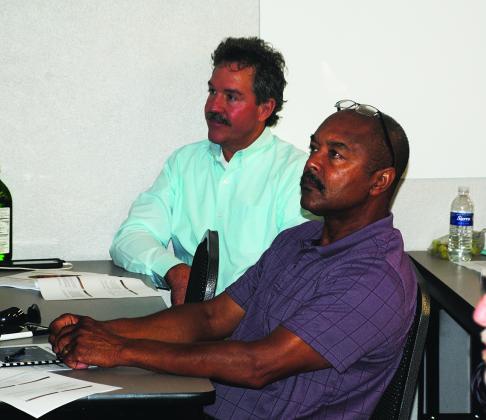Public officials from the city and county gathered at the Snyder Fire Department Monday to learn about the procedures in place in the case of emergencies and disasters.
Greg Goettsch, the District 7 coordinator for the Texas Department of Public Safety (DPS) Division of Emergency Management, led a workshop to educate public officials about responding to and managing an emergency or disaster. The workshop was designed for officials to better understand what needs to be done before, during and after a disaster situation.
“These happen every time elected officials change,” Snyder Fire Chief Perry Westmoreland said. “The fire marshals and I go to these sorts of things all the time. This was a very condensed version for the public officials.”
Goettsch discussed the four phases of the emergency management cycle — prevention/mitigation, preparedness, response and recovery. He talked about how the local governments can help in prevention efforts.
“Planning ahead is a major factor,” Goettsch said. “Engage civic groups and local businesses in the prevention process. Because the recovery process is about how you can get things back to normal after a disaster and it becomes a lot easier when you have done your due diligence beforehand.”
Government Code 418 gives responsibility for handling disasters to county judges and mayors. Local governments are expected to use the resources they have at their disposal before applying for assistance from the state or federal government.
“You need to make sure you have all your T’s crossed and I’s dotted,” Goettsch said. “For example, if you have two guys doing construction during the rebuilding phase, you need to keep track of who was out there and who was doing what and using what equipment, or you won’t get any funding. Documentation is key in getting assistance.”
Westmoreland, who is in charge of the emergency management team in Snyder, said he believed the class was beneficial for the 26 public officials who attended. He said he received positive feedback about the workshop.
“Without a doubt, it was beneficial,” Westmoreland said. “I’ve heard from several people who have said it was good and highly informative.”
Mayor Tony Wofford said he believed the workshop was full of valuable information and said he was grateful the community has Westmoreland leading the charge in the case of a real disaster.
“Thank goodness we haven’t had a huge disaster situation,” Wofford said. “But to have somebody who knows what they’re doing like Perry in charge of our emergency response team is great.”


